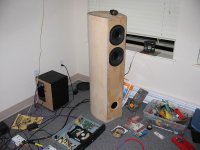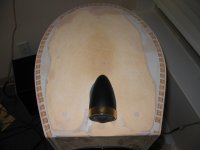Bricolo said:Mr Pass, about the XVR1
is the "gain changing with order" thing avoidable?
Yes. The XVR1 maintains the same gain for 6/12 slopes and then
has a different figure when you go 18/24. There would be
no reason why the gain couldn't be customized to unity, but I
have not chosen to do that. The change can be slight or great
depending on how you set the Q, and of course there is a
volume control at the output of each filter set.
In fact I was wondering how to build something "like" the XVR1
1st to 4th order
variable frequency
fixed gain
without a resistor matrix causing headaches, and even less a capacitor matrix
1st to 4th order
variable frequency
fixed gain
without a resistor matrix causing headaches, and even less a capacitor matrix
Nelson Pass said:About the crossover, I dropped the
project
Can we read this as that there will not be a Pass active crossover for a number of digits ?
Oops, i flunked an entire tube of LT1028's some time ago anticipating a superior solution.
The easiest for my 8 Aleph babies now would be Jens's board, but that means acquiring train loads of opamps again.
Time to think: shall i shoot myself or not ?

As far as I can make out, Jen's filter circuit offers the
equivalent of the project I had, and you need only
insert either op amps or the circuit in the XVR1 owner's
manual. For filled in gain stage values, look at the MOX
thread.
My preference is not for op amps, largely because they need
to be run close to unity gain, and I find the stability marginal.
You can create filters using just unity gain followers, but you
won't get as much flexibility on Q values.
equivalent of the project I had, and you need only
insert either op amps or the circuit in the XVR1 owner's
manual. For filled in gain stage values, look at the MOX
thread.
My preference is not for op amps, largely because they need
to be run close to unity gain, and I find the stability marginal.
You can create filters using just unity gain followers, but you
won't get as much flexibility on Q values.
Nelson Pass said:you need only insert the circuit in the XVR1 owner's
manual.
I take that as a permit to use the XVR1 circuit for a one-off.
Thank you, Mr Pass.
I'm just finishing up the F2 for First Watt, and expect production
in a couple of months.
How many F2's are you going to make?
in a couple of months.
How many F2's are you going to make?
Nelson, I guess that these days you are busy playing with Fostex FE 166 ES-R...
However it would be nice to know if and when we could expect an article on ZEN V8?
That would be a transconductance ZEN, right?
In the meantime, have you tried the FE 166 ES-R in the Kleinhorn?
Enjoy...
However it would be nice to know if and when we could expect an article on ZEN V8?
That would be a transconductance ZEN, right?
In the meantime, have you tried the FE 166 ES-R in the Kleinhorn?
Enjoy...
At the moment I have a backlog of stuff all done except for
the writing. I guess it's about time to start writing.
No, I've so far only had it in a folded QWTP, or FQWTP.
the writing. I guess it's about time to start writing.
No, I've so far only had it in a folded QWTP, or FQWTP.
MikeW said:How many F2's are you going to make?
How many are you going to buy?
😎
How many are you going to buy?
As many as I need. 😀
What else do I need to go with them?

Will I have to sell one of my cars, or my Donzi?

Member
Joined 2002
jleaman said:My new speakers Running off a pair of gain clone's till my other amps get here : O)
Do you find hiding the ugly *** speakers in a pandimonium of chaos somehow distracts the eye from the fact that the speakers are still nude?? 🙂
Maybe you think that veneer will color the sound? Come on Dude dress your speakers!!
BTW. How do they sound?
Regards
Anthony
Member
Joined 2002
They Sound awesome. I Love em. there 2.5 way speakers. a cap on the tweeter a coil on the bottom driver and the middle one is full range. They need new binding post's on the back so i can bi-amp them with a amp per each speaker so 6 channel's with a active x-over i'm thinking about using my pen-zen's a i have 4 boars just need to get them here also and finnish them but also to build chassis for my aleph and see how they sound also. I'm thinking about some ideas for a finnish. It's hard because i want it done right the first time and want to be happy with what i choose. Id like to change a few things put a base on them and change the internal stuffing and wire to some nice hi grade stuff.
Any way chris did a fantastic job im happy that i was able to buy them.
Here is a shot of the top..
Any way chris did a fantastic job im happy that i was able to buy them.
Here is a shot of the top..
Attachments
The KleinHorn Part 2 is done, and will be posted by Mr. Harrington
at www.passdiy.com in the next day or so.
at www.passdiy.com in the next day or so.
Mr. Pass,
I read your second installment of the Kleinhorn saga with great enjoyment. More proof that the journey is more fun than arriving at the destination.
I have looked forward to this article because of the promised use of the current amp with a ribbon tweeter. You did not disappoint. I have a couple of things I'm curious about.
1) What is the sonic difference and measured difference between running the tweeter with a current amp vs, a voltage amp like the A3. Did you try both?
2) Why did you use an active crossover on the tweeter rather than a passive current source filter on the output of the amp. A two pole would have given you a cap in series with the driver and kept any DC offset out of the transformer.
3) Is Fig.7 the entire network that exists between the current amp and the driver? If it is then it must include the bandpass filter, the impedance smoothing network and the driver EQ function. When I read the article on current source crossovers I wondered how the driver impedance/EQ components would be integrated with any crossover components. Fig. 7 and the supporting text (I make joke) seem to suggest that this is seriously empirical territory.
By the way, any plans to put the 166ES-R into the hot seat in the KH's?
Thank you again.
Graeme
I read your second installment of the Kleinhorn saga with great enjoyment. More proof that the journey is more fun than arriving at the destination.
I have looked forward to this article because of the promised use of the current amp with a ribbon tweeter. You did not disappoint. I have a couple of things I'm curious about.
1) What is the sonic difference and measured difference between running the tweeter with a current amp vs, a voltage amp like the A3. Did you try both?
2) Why did you use an active crossover on the tweeter rather than a passive current source filter on the output of the amp. A two pole would have given you a cap in series with the driver and kept any DC offset out of the transformer.
3) Is Fig.7 the entire network that exists between the current amp and the driver? If it is then it must include the bandpass filter, the impedance smoothing network and the driver EQ function. When I read the article on current source crossovers I wondered how the driver impedance/EQ components would be integrated with any crossover components. Fig. 7 and the supporting text (I make joke) seem to suggest that this is seriously empirical territory.
By the way, any plans to put the 166ES-R into the hot seat in the KH's?
Thank you again.
Graeme
gl said:1) What is the sonic difference and measured difference between running the tweeter with a current amp vs, a voltage amp like the A3. Did you try both?
2) Why did you use an active crossover on the tweeter rather than a passive current source filter on the output of the amp. A two pole would have given you a cap in series with the driver and kept any DC offset out of the transformer.
3) Is Fig.7 the entire network that exists between the current amp and the driver? If it is then it must include the bandpass filter, the impedance smoothing network and the driver EQ function. When I read the article on current source crossovers I wondered how the driver impedance/EQ components would be integrated with any crossover components. Fig. 7 and the supporting text (I make joke) seem to suggest that this is seriously empirical territory.
4) By the way, any plans to put the 166ES-R into the hot seat in the KH's?
1) I have listened to both, and I prefer the F1 slightly over an
Aleph 30. The tweeter has a flat impedance and doesn't
particularly care (the response curve looked the same) but I
attribute the difference to the lack of feedback.
2) I failed to mention that I placed a bundle of parallel Zen
capacitors in series with the tweeter. The filter it imposes is
500 Hz.
3) Fig 7 is the loading of the F1 into the DX4. In addition, there
is a single pole on the top and bottom before the amplifier as
mentioned in the text.
4) Actually this weekend I'm planning the TAD 1201's and
4001's with the Emlar horns.
😎
Mr. Pass,
Thank you for the reply. I stand corrected on point 3.
On point 2) did you try a passive current source crossover with the tweeter as an alternative to the XVR1?
Thanks.
Graeme
Thank you for the reply. I stand corrected on point 3.
On point 2) did you try a passive current source crossover with the tweeter as an alternative to the XVR1?
Thanks.
Graeme
No, but it was so well behaved I have no doubt it could be
made to work. I just didn't want to fuss with the level
adjustment.
😎
made to work. I just didn't want to fuss with the level
adjustment.
😎
- Home
- Amplifiers
- Pass Labs
- DIY progress report


